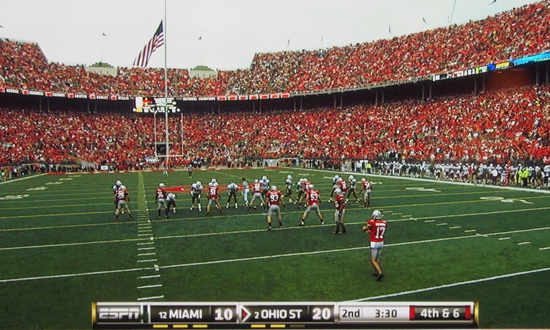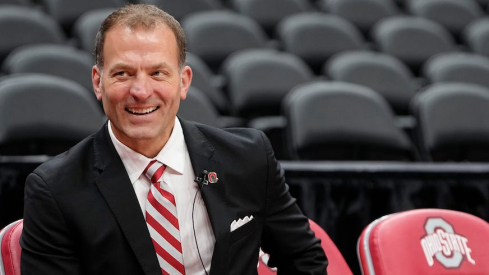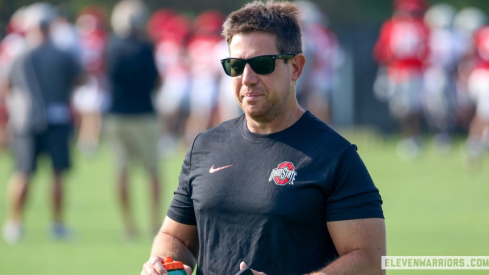Coming off the dismantling of Miami, the soul warming glow of victory still radiates. Sending the Hurricanes back with another loss lends itself to a cruel sense of satisfaction knowing their misery has only deepened. Oh, how I love it so but that’s not to say there weren’t problems. Generally speaking, the game critiques fall in one of a couple categories like the goofy clock management at the end of the half or the anemic redzone touchdown efficiency. Those pale in comparison, however, to the outright disgust regarding the kickoff and punt coverage units.
It has all been well documented by now. Ohio State’s problems covering punts and kickoffs date back to Mycenae or maybe it was a bit after. We, at times, have been Tresselballed in a special teams sense. It’s kept teams in games, changed momentum and flipped the field more than we care to remember. Both Miami and Ohio State would have been substituting liberally by the fourth quarter if it weren’t for the two glaring breakdowns which provided the faint heartbeat for the boys from South Florida.
So, we know we have a problem but what’s the cause? That certainly is something the staff is working on but pinpointing the exact cause or common problem is difficult work. The Dispatch had their crack yesterday quoting some past and former players but putting my diagnostic cap on, I come up with three main issues that seem to be prevalent.
The Spread Punt Formation Isn’t Working
The staff has addressed the punt coverage in one interesting way. I’m not sure when exactly it was instituted but in the last year or so, the Buckeyes have moved to a spread punt formation. This formation places seven players horizontally at the line of scrimmage with much wider splits than normal. Then, there is a group of three blockers just in front of the punter called 'the shield'. The players are usually beefer lineman who pick off oncoming rushers who are attempting the block the kick.

The principles behind it are sound on paper. The main goal is help in punt coverage because the seven players immediately rush downfield to cover the kick. But, there’s a problem. It doesn’t work - at least not for our team. One problem is you have a relatively new concept being implemented and another is player personnel. Should the player break the return, he’ll typically only have to beat the three players who make up the shield and a punter, none of which are geared for tackling jitterbugs in the open field. If that were to happen, immediately praying for the turf monster to make a magical tackle. Jaamal Berry knows.
I’d much prefer us to return to a standard punt formation. It’s what we know and it’s what has been successful in the past. And, I haven’t even gotten into the idea that more kicks seem to be blocked in the spread formation. Implementing the spread punt at some point down the line is fine but only after it’s been perfected and practiced enough times because we’ve tried it twice now (2007 was the other year) and it hasn’t worked either time. It’s absolutely fine to shelve something when it’s not working, even if everyone else is using it.
Poor Kick Placement
Often overlooked, kick placement plays a large role for the coverage units especially when it comes to punts. Using the sideline as a defender is a powerful weapon against teams with explosive returners because it limits options. The returner is forced to work within a constrained space where coverage units can ‘squeeze’ the play to the sideline. It also will trigger a higher percentage of fair catches or punts that go unfielded, all of which are wins for the coverage team. Of course, angling kickoffs is riskier business when you have a kicker who struggles to reach the endzones. Kicks that find themselves out of bounds are placed on the 40 yardline, in effect giving up a big return.
Unfortunately for Ohio State, many of the kicks and punts have been between the hashes. Derrell Johnson-Koulianos’s return in the Iowa game last year started on the near hash. At least one of Oregon's Kenjon Barner's returns started almost exactly in the field as did the both touchdown returns Saturday. It sounds elementary but it gives the returner options and it forces the coverage team to have great discpline by staying in their lanes for a longer period. The alternative is playing defense with the kick by pooching or squibbing it but, again, the effectiveness of both of these techniques is placement.
Breaking Down
No matter where the punt is placed or the formation it originated, players still should make the play when in position. Breaking down is a fundamental taught at young age but it’s been absent far too often.
On Miami’s punt return, two Ohio State players were in position to make the tackle as the ball was being caught. Instead, both overran the play and removed themselves from lending any further help to their teammates. I can appeciate the desire to keep your speed in order to make the tackle as quick as possible, but one also needs to slow down, gather balance and make the tackle or funnel the direction of the play to another teammate. To his credit, Miami player Travis Benajmin did use a deceptive move by backing up and then running into the catch. But, that or any other reason isn't a good excuse to give up six.
Needless to say, there is much work to do and things to tweak for special teams when you are ranked 109th and 113th in punt and kick coverage, respectively.

